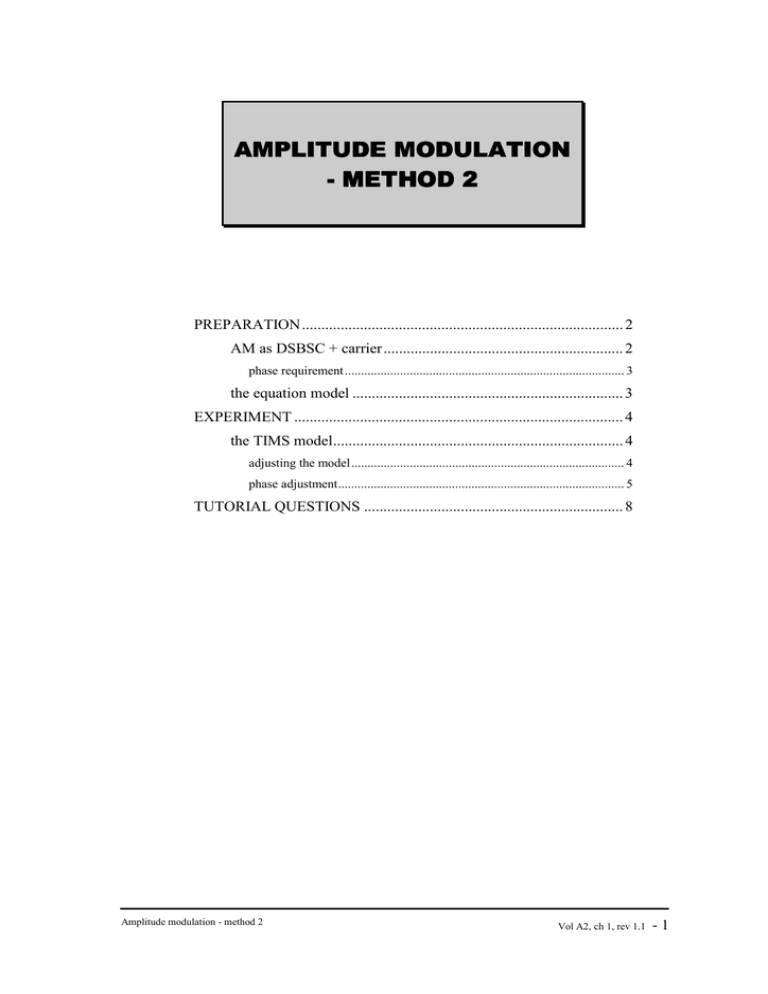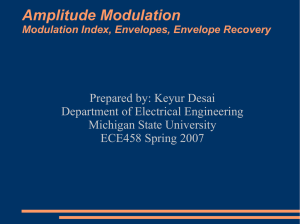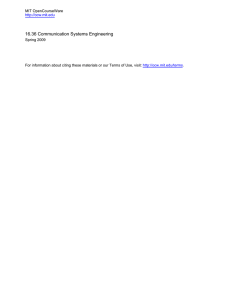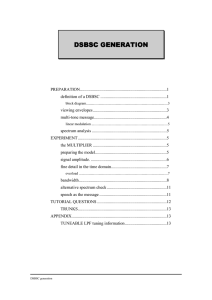AMPLITUDE MODULATION
advertisement

AMPLITUDE MODULATION - METHOD 2 PREPARATION................................................................................... 2 AM as DSBSC + carrier.............................................................. 2 phase requirement ...................................................................................... 3 the equation model ...................................................................... 3 EXPERIMENT ..................................................................................... 4 the TIMS model........................................................................... 4 adjusting the model.................................................................................... 4 phase adjustment........................................................................................ 5 TUTORIAL QUESTIONS ................................................................... 8 Amplitude modulation - method 2 Vol A2, ch 1, rev 1.1 -1 AMPLITUDE MODULATION - METHOD 2 ACHIEVEMENTS: another method of modelling an amplitude modulated (AM) signal (see the experiment entitled Amplitude modulation in Volume A1); indirect method of phase measurement. PREREQUISITES: completion of the experiment entitled Amplitude modulation in Volume A1 would be an advantage. PREPARATION AM as DSBSC + carrier There are many ways of generating an amplitude modulated (AM) signal. Refer to a text book for some of them. The class C modulated amplifier is a popular circuit. If the prime requirement of a transmitter is to generate AM, then this (or variations of it) is probably the best choice. But sometimes it is a secondary requirement. For example, a transmitter might primarily be designed for DSBSC generation. An ability to synthesise AM might be a secondary requirement; a suitable method is examined in this experiment. In the experiment entitled Amplitude modulation (in Volume A1), you have already modelled the AM equation in the form of: ........ 1 AM = E.(1 + m.cosµt).cosωt There are other methods of writing this equation; for example, by expansion, it becomes: ........ 2 AM = E.m.cosµt.cosωt + E.cosωt = DSBSC + carrier ........ 3 The depth of modulation ‘m’ is determined by the ratio of the DSBSC and carrier amplitudes, since, from eqns.(2) and (3): ........ 4 ratio (DSBSC/carrier) = (E.m) / E = m 2 - A2 Amplitude modulation - method 2 phase requirement The important practical detail here is the need to adjust the relative phase between the DSBSC and the carrier. This is not shown explicitly in eqn. (2), but is made clear by rewriting this as: ........ 5 AM = E.m.cosµt.cosωt + E.cos(ωt + α) Here α is the above mentioned phase, which, for AM, must be set to: ........ 6 α = 0o Any attempt to model eqn. (2) by adding a DSBSC to a carrier cannot assume the correct relative phases will be achieved automatically. It is eqn. (5) which will be achieved in the first instance, with the need for adjustment of the phase angle α to zero. the equation model A block diagram of the arrangement for modelling eqn. (2) is shown in Figure 1. ext. trig CH1-A message (sine wave) DSBSC g AM out CH2-A G 100 kHz (sine wave) carrier adjust phase Figure 1: block diagram of AM generator Amplitude modulation - method 2 A2 -3 EXPERIMENT the TIMS model The block diagram of Figure 1 can be modelled by the arrangement of Figure 2. CH1-A ext. trig CH2-A note use of quadrature carriers Figure 2: the AM generator model adjusting the model You will now set up a 100% amplitude modulated signal using the model of Figure 2. The DSBSC and the carrier from which it is derived are required to be in phase for the generation of AM. Examination of Figure 1 might suggest that no phase adjustment is required, since the DSBSC and carrier should be already in phase. But the DSBSC and carrier are taken via separate paths to the ADDER, and these paths, and the ADDER, can introduce small and unknown (but stable) phase shifts. Thus at the adding point the two may not be in exact phase. A correction may be necessary. It is the purpose of the PHASE SHIFTER to make this small correction. The PHASE SHIFTER itself cannot introduce a small phase shift, even if the front panel control is fully anti-clockwise. This may, in any case, be in the wrong direction. To overcome this possible problem the carriers to the PHASE SHIFTER and to the MULTIPLIER (for the DSBSC generation) have already been shifted by 900 by using the quadrature outputs from the MASTER SIGNALS module. Thus the PHASE SHIFTER is required 4 - A2 Amplitude modulation - method 2 to introduce a further small adjustment either side of ±900, which is in its midrange of control, rather than at one end. T1 patch up the model of Figure 2. Remember to set the on-board switch of the PHASE SHIFTER to the ‘HI’ (100 kHz) range before plugging it in. T2 set the gain controls g and G of the ADDER fully anti-clockwise. T3 set the oscilloscope to accept the ‘ext. trig’ signal, and adjust sweep and gain controls so that the message is displayed on CH1-A, filling about the top half of the screen. T4 set the gain control of the oscilloscope CH2 to the same as that of CH1. T5 without touching the sweep speed of the oscilloscope adjust the amplitude of the carrier signal, using the G control on the ADDER, so it is about 2 volts peak-to-peak, but exactly aligned between two horizontal lines of the oscilloscope graticule. T6 temporarily remove the carrier signal from the G input of the ADDER T7 advance the ADDER gain control g until the DSBSC is displayed on CH2A of the oscilloscope between the same two graticule lines as was the carrier. T8 replace the carrier term into the G input of the ADDER. You have now set up the signal of eqn. (4), except for the phase angle α. The output of the ADDER is expected to be a 100% amplitude modulated AM signal, but only if the relative phase is correct; that is, α = 0. It is an easy matter to adjust the phase: T9 vary the front panel control of the PHASE SHIFTER until, watching the display for CH2-A of the oscilloscope, a 100% AM is achieved. Q although no instruction was given about how you might recognise the required phase condition, did you find this self evident ? Explain. phase adjustment The above instruction offers no advice as to how the correct phase adjustment is to be achieved. But if you try it, there will be little doubt as to what to do. Amplitude modulation - method 2 A2 -5 You will notice that there is only one position of the PHASE SHIFTER control when the troughs of the signal will exactly ‘kiss’, as is expected for 100% AM. The ‘kiss’ occurs when α = 0. This is clearly illustrated in Figure 3. Figure 3: showing envelope for small phase errors From a practical point of view the ‘kiss’ test is adequate as a method of phase adjustment. But remember it must be made under conditions for m = 1 - that is, with equal amplitude DSBSC and carrier signals at the ADDER output, and a sinusoidal message. For an error of 5 degrees Figure 3 shows clearly that the troughs will not kiss; this is even more obvious for an error of 10 degrees. α Am Am 2 2 A Am 2 A phase = 0 phase = Phasor Form α ω−µ ω ω + µ frequency Amplitude Spectrum Figure 4: DSBSC + carrier, with m = 1 Representation of the DSBSC and carrier in phasor form is shown in Figure 4. This is another way of looking at the signal. It is clear that, when the phase angle is other than zero, no matter what the sideband amplitude, they could never add with the carrier to produce a resultant of zero amplitude, which is required for the ‘kiss’. When the sidebands are in phase with the carrier, this can clearly only happen when m = 1 (as it is in the diagram). 6 - A2 Amplitude modulation - method 2 Figure 4 also shows the amplitude spectrum. This is not affected as the phase changes. There are other methods of phase adjustment. One would be to recover the envelope in an envelope detector (see earlier experiments) and adjust the phase until the distortion of the recovered envelope is a minimum. This is a practical method which achieves directly what is desired - without ever having to measure relative phase. In this way there may be some compensation for the inevitable distortion introduced both by the transmitter, at high depths of modulation, and the receiver. Amplitude modulation - method 2 A2 -7 TUTORIAL QUESTIONS Q1 show, with the aid of a phasor diagram, that, when the DSBSC and the carrier are of the same amplitude (the condition for 100% AM), the only way for them to periodically sum to zero is for their relative phase to be zero. This is the condition for the troughs to ‘kiss’. As an extension of this, show that, for m < 1, they could never kiss. Q2 how could you use a commercial phase meter to measure the relative phase between a carrier and a DSBSC ? Q3 there was no need to make an explicit phase adjustment when modelling eqn. (1), whereas this was necessary when modelling eqn. (3). These two equations model the same signal. Comment. Q4 if an AM signal was connected to the FREQUENCY COUNTER, would it read: a) the carrier frequency ? b) the envelope frequency ? c) what ? Explain ! 8 - A2 Amplitude modulation - method 2



